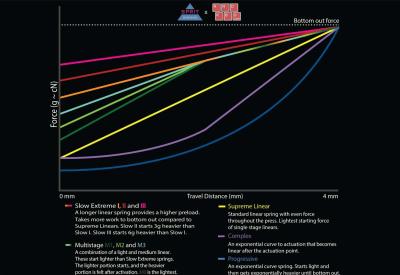QUOTE(Moogle Stiltzkin @ Jun 15 2025, 03:53 AM)
but some of the options now got so many switches hard to keep up and figure whats what
https://aulagear.com/products/aula-f108-pro...=41802068033632here got this model mkb, and different color theme (colors and the keycap styles). Then they all have different switch tied to that theme. so if the switch u like is on a color scheme u dont like then tough

LEOBOG Reaper Mechanical Switch
LEOBOG Greywood V3 Switch
LEOBOG Nimbus V3 Switch
LEOBOG Reaper Mechanical Switch
when i look at this im like wtf.... i only ask the question, is it linear? tactile? clicky or non clicky? actuation force? what stems? does the mkb have stabilizers?
Last time it used to be simpler with the cherry mechanical switches. it was black, red, blue, brown. Thats all u had to know and you knew which color had what characteristics etc. Now it's just chaos and confusion

these days i think a mkb necessarily needs to be a cherry mx. as long as it's good enough. and i would say most people want it to be a stem where their keycaps can easily be used in other similar stem mkbs, if they are modding it or replacing worned out keycaps.
anyway always check the reviews prior to purchase. they will usually cover everything including switches to see if its suitable for you or not.
it's just a similar concept like old days, e.g., a filco majestouch 2 with cherry mx red/pink/black/brown/blue. back then, cherry mx started the standards (by using stem color as identifier), and every clone followed to avoid confusions.
however, it's hard to tell which is which today, because there are no more defined standards to cover all variants, i.e., users' syok-sendiri becomes manufacturers' syok sendiri. on the other hand, the good news about modular boards is that you can replace key switches yourself rightaway. just get an extra set of key switches that you want and do the replacement. (it's much more convenient than before, i.e., compared to the era of soldered prebuilts) if you buy a board/key switch based on themes, it's another story. to me, themes are just another good-to-have created by vendors to sell stuff. it's not helpful in typing sound/feel.
everytime i look at a new switch, i will look for its technical specifications first. if there is none, i just skip. for a beginner, i will suggest getting a mx style key switch with its technical specifications, and use it as a reference for comparison purposes. (do this for each actuation type)
a technical specification will show you the following about a stock key switch:
1.
pin number - 3-pin (plate-mount), 5-pin (pcb-mount); if your pcb has 2 side holes per switch, then you can use 5-pin key switches; (you can cut 2 plastic pins off to make it 3-pin, but 5-pin will provide additional structural support for a modular board, so i don't like doing this)
2. stem (also called plunger) - material, standard/extended/long pole, etc., special features;
3. top housing - material, special features;
4. bottom housing - material, special features;
5.
actuation type - linear/tactile/clicky;
6. initial force - this is the force to start key travel;
7. actuation force - this is the force to register a key stroke;
8.
bottom-out force - this is the force to get to the bottom of a key switch;
9. pre-travel - this is the distance from resting point to actuation point; normally it's 2mm;
10.
total travel - this is the distance from resting point to bottom-out point; conventionally it's 4mm; however these days, there are shorter total travels, e.g., 3.4mm
11.
spring - material, spring type (linear-rated, progressive, muti-stage, short, long, etc.);
12. lubrication - factory pre-lubed or not; normally, there are minimal lubration applied to key areas (all key switches are supposed to be pre-lubed), but these days, the amount of lube has increased to promote user-preferred smoothness;
13. special features, e.g., the presence of diffuser plastic for better lighting effects.
usually, a more complete technical specification also provides force-travel diagram. different spring types will have their unique patterns in the diagram.
» Click to show Spoiler - click again to hide... «

these are basic force curve patterns, based on sprit design's springs.
normally, the parts in bold should be good enough for you to choose a stock switch that you're ok to use it as-is. compared to old days (linear-rated springs only), the new variants are spring weight/type, and total travel (mainly due to long/extended stem poles, or shallower stem well in bottom housing). these are common now, e.g., one key switch with multiple spring weights. in general, you should know your spring range, for different spring types. outside of the spring range (of a particular spring type), you will have issues, e.g., unable to register key strokes randomly, because the initial force is heavier than your usual; your finger joints are now painful after typing for a while; if it's too light, you will have something likkkkkkkkkeeee thisssssssss, and backspace suddenly becomes your good friend, etc. (you can experiment by replacing different spring types in your reference key switches first, to get approximate ideas)
yes, as always, do research first before purchase.
edit: well, there are more but i don't wanna go too far. the above should cover almost everything for key switch purchase for now hehe
This post has been edited by horns: Jun 18 2025, 11:02 AM 

 Jun 11 2025, 01:06 PM
Jun 11 2025, 01:06 PM

 Quote
Quote
 0.0177sec
0.0177sec
 0.30
0.30
 6 queries
6 queries
 GZIP Disabled
GZIP Disabled